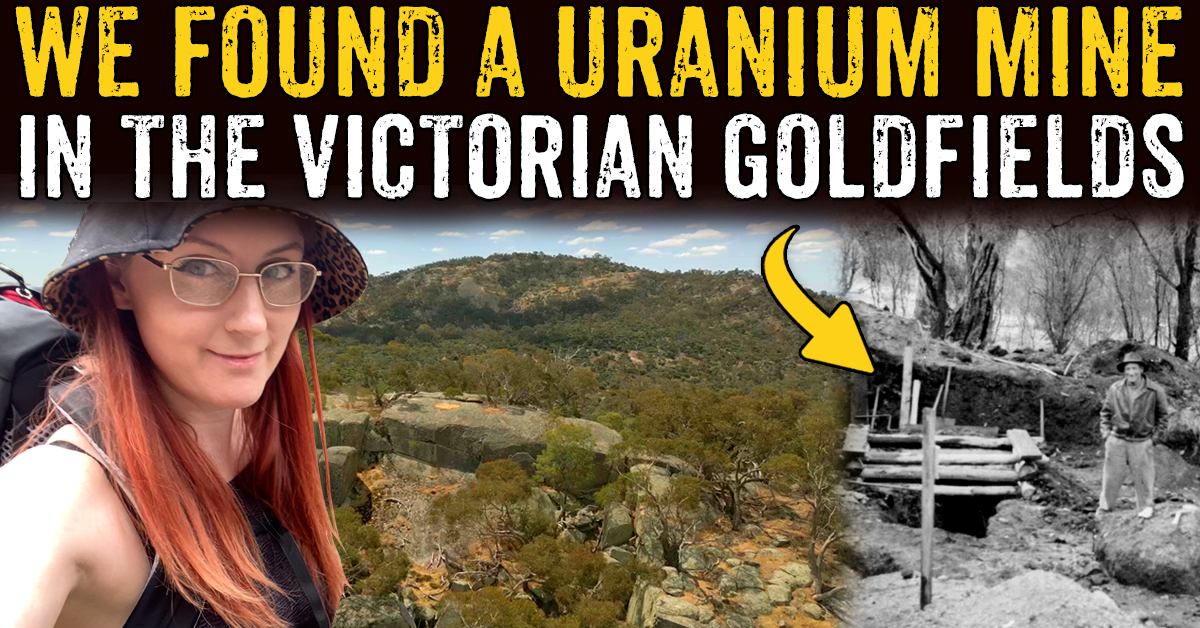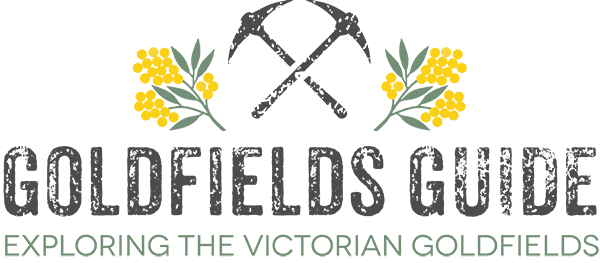
The Victorian Goldfields region is well known for its incredible gold mining history - massive nuggets, rich quartz reefs, and buried riverbeds full of gold. But did you know that we had our very own Uranium rush back in the 1950s?
In this article, we're going to look into the story of how two brothers from Kingower made this incredible discovery, and then I'm heading out with historian and author John Tully on an adventure to search for the remote site of their Uranium mine.
You can watch the video on YouTube, or continue reading below.
The Uranium rush!
Situated about 45 minutes from Bendigo, Kingower has been a popular spot for prospectors ever since the gold rush of the 1850s. Many people have spent their days searching here for the precious metal, and back in the early 20th century, brothers Sam and Bill Macumber were no exception.
Surfaced area at Kingower, Victoria
Born in Kingower and working in their youth as timber cutters, these brothers grew up prospecting, and spent much time searching for gold in the bush around the area, always hoping to strike it rich.
They prospected for gold as well as wolfram, feldspar, and other rare minerals for many years, and Bill worked for a few years in the Bendigo gold mines. In 1921, after seeing plenty of colour over their time but making no rich strikes, they left the area and moved to Melbourne.
Over thirty years later, when they were both around 60 years old, Bill was working as a railway gate keeper on the Brunswick railway line, and Sam was working in a brewery. Both were married, and had families.
Now, as many of you probably know, the prospecting bug never leaves you, and in the early 1950's the brothers read of Uranium finds in the north, taking particular note of the descriptions of the land where it was being discovered. They remembered the granite hills around Kingower, and strange outcrops of unusual rock that they had come across, that they had never understood in their gold hunting days.
The brothers became convinced that there was something significant going on up in the granite outcrops near Kingower. After talking it over for a while, they decided to get a Geiger counter from the Mines Department.
They took a week holiday and headed back up to Kingower to look over the country again.
They drove up to Mount Kooyoora by car and tramped the rest of the way on foot. Bill said he wasn't surprised when the Geiger counter started ticking over, confirming their suspicions.
It only took a few days to find what they were looking for at the base of a granite outcrop alongside Blind Creek.
Mount Kooyoora, near Kingower Victoria
At first their find was kept secret as they explored the site further, sinking shallow shafts and testing the ground with their Geiger counter.
One day Sam Macumber walked into one of Inglewood's hotels and claimed that he and his brother were going to stir up their town one of these days. Locals thought they were crazy, assuming they were looking for gold up in that granite country, not knowing the true subject of their search.
The brothers took samples and reported their find to the mines department in February 1954. The department investigated and prepared a favourable report, so the brothers formed a syndicate with a group of mates and staked out a claim.
When word got out, Victoria was gripped by Uranium Fever. In both Bendigo and Melbourne, the Mines Department was inundated with inquiries by prospectors seeking the location and nature of the deposit, along with requests to borrow or buy Geiger counters.
These instruments were available for purchase in Melbourne for about £40 to £60 pounds each, and sales were soaring.
Over at Inglewood, many of the businessmen were preparing to join the search for uranium, and the whole town was up in the air, with excitement rising to the levels of the old gold boom days.
Extra beer was ordered in to the Royal Hotel, in anticipation of the growing rush of prospectors and sightseers.
Accommodation issues similar to those caused by the recent gold rush at Wedderburn were anticipated, but many of the prospectors avoided the issue by taking their caravans out the bush.
People were quickly making discoveries with their Geiger counters, but the levels shown by the instruments were too small to be of value.
Nearly all the area likely to yield radio active minerals was already leased by brothers Bill and Sam Macumber. Things were looking very promising for them. If their discovery turned out as well as the Mines Department was hoping, the brothers could be in for a reward of up to £25,000 from the federal government.
Detailed geological surveys were being made to assess the nature and extent of the radio active deposit.
So lets take a closer look into these investigations.
In February 1954, the Mines Department was made aware of evidence of radioactivity in the vicinity of Mount Kooyoora and were asked to investigate, so on the 16th of February, geologists Whiting and Chambers headed out for a closer look.
They checked the Macumber brothers' shallow excavations with a scintillometer, which gave readings up to 15 times the background levels, but curiously, no radio-active minerals could be recognized.
What's more, none of the material which had been taken out of the holes, the deepest of which was four feet, showed any traces of radioactivity.
The prospectors were advised to dig further, and the geologists left them to it for a while.
A month later, once more work had been done at the site, a second investigation was carried out. This time, scintillometer readings up to 25 times background were recorded, and now some of the excavated material was showing slight radio activity.
The radio active deposit was found to be a micaceous ironstone, rich in manganese.
Could this contain Uranium?
Samples were sent to the Department of Mines in South Australia for testing, and were found to contain tiny flakes of the uranium mineral torbernite [ Cu (UO2)2. P2O5. 8H2O ], enclosed in small veins of clayey material. But a chemical analysis showed that the concentration of uranium oxide was less than 0.01%.
So there was Uranium! But it was a low grade secondary deposit, and so the question now, was where did it come from?
Well there were two options - it was either from a mineralised vein underlying the ironstone, or it was the result of precipitation from mineralized ground waters.
Determined to find out, the government planned a drilling program to test the first possibility. Eleven diamond drill holes were put down in the vicinity of the Macumber brothers workings.
Tests of the bore holes reveals varying levels of radio activity, but the only traces of ore mineral in the cores were small concentrates of pyrite.
It appeared that the most likely source of the uranium here was precipitation from ground water. Uranium minerals are soluble in the presence of sulphuric acid, formed by the decomposition of pyrite.
In solution, the uranium minerals could be transported for considerable distances before conditions became favourable for precipitation.
Overall, the investigation carried out in the vicinity of Mount Kooyoora found that the uranium deposit was a localised, secondary deposit. It was very low grade, and even in great quantities the levels of uranium would not be payable.
There was little hope for the existence of a high grade primary ore deposit in the area - which must have come as a great disappointment to the Macumber brothers.
Regardless, Victoria was fascinated by prospects of Uranium, and an aerial scintillometer survey was carried out over the area, as well as several other locations of interest.
But that was about it for the Macumber brother's Uranium rush near Inglewood.
So what has become of the Macumber brothers' mine today?
Keen to find out, I headed out to the Kooyoora State Park to take a look around with historian, John Tully, who had explore the site before, many years ago. But as this mine has not been marked on any maps, we had to search for the spot through very difficult country.
Historian and author, John Tully
We knew the Uranium discovery was made beneath a distinctive granite ledge along Blind Creek, which we had photos of, so armed with John's Geiger counter, off we went.
The photos showed the appearance of the granite outcrop around the Macumber brothers mine, but let me tell you, finding a specific rock in a sea of rocks shrouded by trees up in the Kooyoora State Park is no easy task.
A newspaper article described the scene in April, 1954. The workings were set in a remote, thickly timbered location, which was reached by heading over sheep tracks and up the mountainside.
A shaft was being sunk at the foot of a granite outcrop. Picks, shovels, crowbards, a winch and buckets, had been brought to the site from the men's camp, which was about 300 yards below the workings. Near the shaft, pieces of broken granite showed traces of black deposits.
After a long time spent exploring the granite outcrops, we found the spot!
So this is the site where the Macumbers' syndicate was working, and the scene is just the same as it was described in the reports.
We can still see their shafts, a drainage channel they'd cut, and piles of the ironstone they'd been digging out.
You can picture the scene here as though they were here yesterday.
We checked various places around their workings with John's Geiger counter. We found that levels were pretty low around the mine shafts.
John Tully with his Geiger counter
The highest reading was at the base of the granite ledge - which had been marked as the zone of highest radioactivity in the geological reports. We found it was about 5 times the background reading for the area, sitting up around 90 usv/h
John Tully with his Geiger counter
I wonder what this place might have looked like today if the Macumber's uranium discovery had turned out to be of commercial value.
We might have had our very own Rum Jungle, right here beneath Mount Kooyoora.
References
THOMAS, D.E., 1954. Report on radio activity, Mt Kooyoora. Geological Survey of Victoria Unpublished Report 1954 17. Department of Mines, Victoria, 3 pp.
SPENCER-JONES, D. & BELL, G., 1954. Radioactive deposit near Mount Kooyoora, Inglewood. Geological Survey of Victoria Unpublished Report 1954-24. Department of Mines, Victoria, 14 pp.
Radioactive Deposit Near Mount Kooyoora, Inglewood, By D. SPENCER-JONES, B.Sc., and G. BELL, B.Sc., Geologists, 1955
Historical images of the Macumber Brothers' mine - Geological Survey of Victoria
Newspaper articles - Trove
Image - John Tully holding Welcome Stranger gold nugget replica - thanks to Rachel Buckley.


